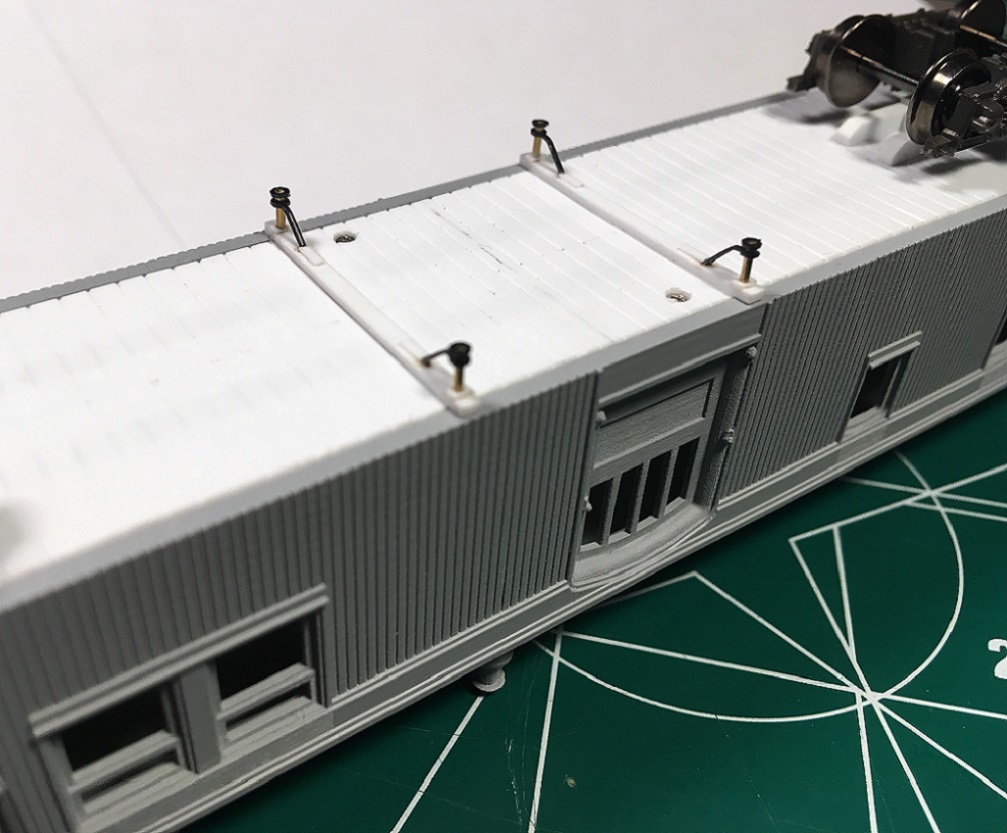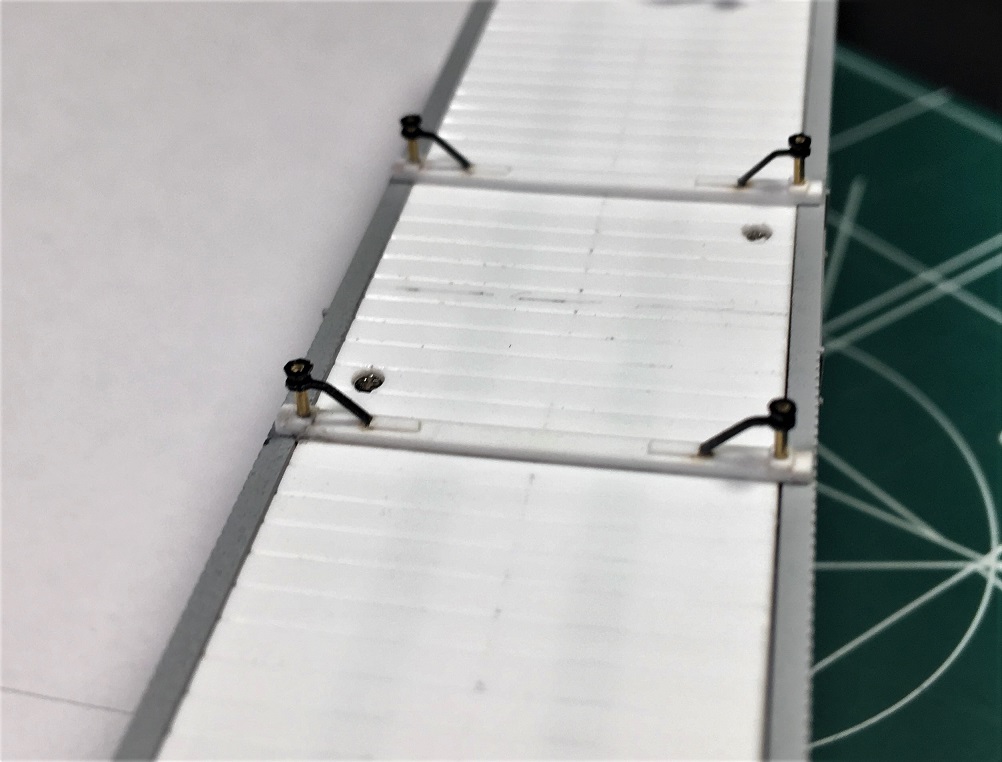Re: C&S RPO 11: Decals
Posted by Jim Courtney on Dec 29, 2018; 3:46am
URL: http://c-sng-discussion-forum.254.s1.nabble.com/C-S-RPO-11-Linn-Moedinger-s-Shapeways-Print-in-Sn3-and-Hon3-tp12427p13022.html
Speaking of needle beams and queen posts . . .
The cast brass parts that Keith is using on his Sn3 RPO 11 were cast quite a few years ago, as part of a run of passenger car kits by The Cimarron Works. With the diagonal brace from queen post to needle beam and the small truss rod along the length of the needle beam, this arrangement was typical for most C&S passenger cars, including RPO 13 and Coach 70, as documented in the Quick Pic Books.
No such part exists in HOn3, so I had to figure out how to make them from scratch.
I studied the underframe photo of the TOC wreck of RPO 11 at Foxton (up thread) to see how the queen posts and braces were made. It looked to me as if the queen post braces on RPO 11 were different: The braces seemed to be attached a bit higher on the queen post, and the brace itself wasn't diagonal, more of an "S" shape, attaching to the queen post with a yoke or ring, running straight back toward the center of the car, then curving up and back, flattened and attached to the needle beam with bolts.
It occurred to me that the braces may have been replaced with a standard design (like Keith's) in the 'teens when the RPOs were rebuilt. It is extremely hard to visualize the queen post braces in the few later 1930's photos. But fortunately, Otto Perry rode the train from Denver to Leadville on snowy day in 1934, and took this photo:
http://digital.denverlibrary.org/cdm/singleitem/collection/p15330coll22/id/42479/rec/27

The same "S" shaped brace is in evidence in 1934.
I thought it would be cool to try to model this detail on my HOn3 RPO 11; this is what I came up with:

The queen post base is made of 0.010 x 0.040 Evergreen strip. The queen posts themselves are 0.019" brass wire. To model the braces, I used Tichey HO scale O-rings, that have a long plastic stem, the center drilled out to 0.020". The stems were bent upward around a drill bit for consistency, the stems trimmed and secured to the needle beams with MEK. The attachment to the needle beam is suggested with small pieces of 0.010 x 0.030 styrene (Tichey rivets to represent bold heads to follow).

The queen posts are located just above the seam between the car body sides and the styrene floor. I'm going to have to bend the truss rods from 0.015' brass wire and attach them to the queen posts and the floor at the 4 little tabs created earlier. I used a second Tichy O-ring with stems removed at the very bottom of the queen posts, hoping to cut off the web of Grandt plastic queen posts and secure them to the bottom of the queen post with MEK -- so far that hasn't worked.
Whew! All the time doing this tedious stuff with loops can give a guy a headache. Perhaps I should have done an Sn3 car instead . . .
URL: http://c-sng-discussion-forum.254.s1.nabble.com/C-S-RPO-11-Linn-Moedinger-s-Shapeways-Print-in-Sn3-and-Hon3-tp12427p13022.html
Speaking of needle beams and queen posts . . .
The cast brass parts that Keith is using on his Sn3 RPO 11 were cast quite a few years ago, as part of a run of passenger car kits by The Cimarron Works. With the diagonal brace from queen post to needle beam and the small truss rod along the length of the needle beam, this arrangement was typical for most C&S passenger cars, including RPO 13 and Coach 70, as documented in the Quick Pic Books.
No such part exists in HOn3, so I had to figure out how to make them from scratch.
I studied the underframe photo of the TOC wreck of RPO 11 at Foxton (up thread) to see how the queen posts and braces were made. It looked to me as if the queen post braces on RPO 11 were different: The braces seemed to be attached a bit higher on the queen post, and the brace itself wasn't diagonal, more of an "S" shape, attaching to the queen post with a yoke or ring, running straight back toward the center of the car, then curving up and back, flattened and attached to the needle beam with bolts.
It occurred to me that the braces may have been replaced with a standard design (like Keith's) in the 'teens when the RPOs were rebuilt. It is extremely hard to visualize the queen post braces in the few later 1930's photos. But fortunately, Otto Perry rode the train from Denver to Leadville on snowy day in 1934, and took this photo:
http://digital.denverlibrary.org/cdm/singleitem/collection/p15330coll22/id/42479/rec/27

The same "S" shaped brace is in evidence in 1934.
I thought it would be cool to try to model this detail on my HOn3 RPO 11; this is what I came up with:

The queen post base is made of 0.010 x 0.040 Evergreen strip. The queen posts themselves are 0.019" brass wire. To model the braces, I used Tichey HO scale O-rings, that have a long plastic stem, the center drilled out to 0.020". The stems were bent upward around a drill bit for consistency, the stems trimmed and secured to the needle beams with MEK. The attachment to the needle beam is suggested with small pieces of 0.010 x 0.030 styrene (Tichey rivets to represent bold heads to follow).

The queen posts are located just above the seam between the car body sides and the styrene floor. I'm going to have to bend the truss rods from 0.015' brass wire and attach them to the queen posts and the floor at the 4 little tabs created earlier. I used a second Tichy O-ring with stems removed at the very bottom of the queen posts, hoping to cut off the web of Grandt plastic queen posts and secure them to the bottom of the queen post with MEK -- so far that hasn't worked.
Whew! All the time doing this tedious stuff with loops can give a guy a headache. Perhaps I should have done an Sn3 car instead . . .
Jim Courtney
Poulsbo, WA
Poulsbo, WA
| Free forum by Nabble | Edit this page |